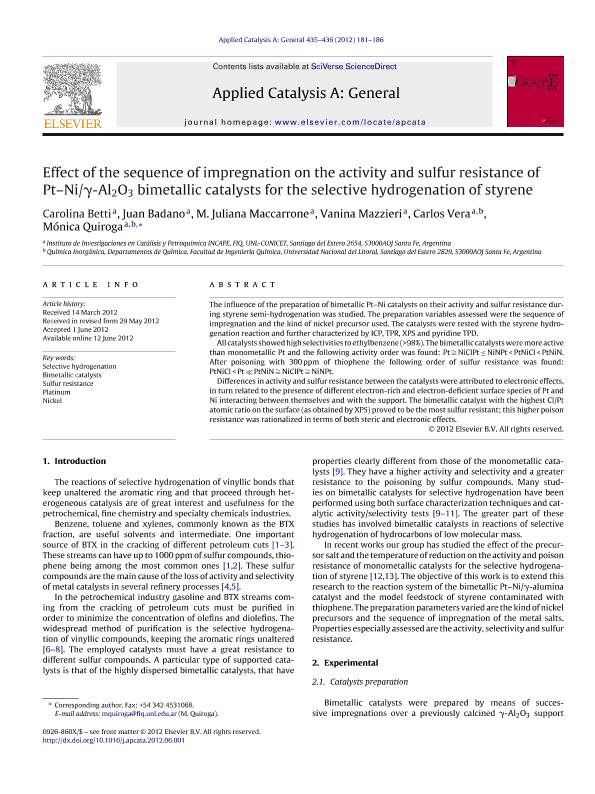Artículo
Effect of the sequence of impregnation on the activity and sulfur resistance of PtNi/-Al2O3 bimetallic catalysts for the selective hydrogenation of styrene
Betti, Carolina Paola ; Badano, Juan Manuel
; Badano, Juan Manuel ; Maccarrone, María Juliana
; Maccarrone, María Juliana ; Mazzieri, Vanina Alejandra
; Mazzieri, Vanina Alejandra ; Vera, Carlos Roman
; Vera, Carlos Roman ; Quiroga, Monica Esther
; Quiroga, Monica Esther
 ; Badano, Juan Manuel
; Badano, Juan Manuel ; Maccarrone, María Juliana
; Maccarrone, María Juliana ; Mazzieri, Vanina Alejandra
; Mazzieri, Vanina Alejandra ; Vera, Carlos Roman
; Vera, Carlos Roman ; Quiroga, Monica Esther
; Quiroga, Monica Esther
Fecha de publicación:
06/2012
Editorial:
Elsevier Science
Revista:
Applied Catalysis A: General
ISSN:
0926-860X
Idioma:
Inglés
Tipo de recurso:
Artículo publicado
Clasificación temática:
Resumen
The influence of the preparation of bimetallic Pt–Ni catalysts on their activity and sulfur resistance during styrene semi-hydrogenation was studied. The preparation variables assessed were the sequence of impregnation and the kind of nickel precursor used. The catalysts were tested with the styrene hydrogenation reaction and further characterized by ICP, TPR, XPS and pyridine TPD. All catalysts showed high selectivities to ethylbenzene (>98%). The bimetallic catalysts were more active than monometallic Pt and the following activity order was found: Pt ≅ NiClPt ≤ NiNPt < PtNiCl < PtNiN. After poisoning with 300 ppm of thiophene the following order of sulfur resistance was found: PtNiCl < Pt ≪ PtNiN ≅ NiClPt ≅ NiNPt. Differences in activity and sulfur resistance between the catalysts were attributed to electronic effects, in turn related to the presence of different electron-rich and electron-deficient surface species of Pt and Ni interacting between themselves and with the support. The bimetallic catalyst with the highest Cl/Pt atomic ratio on the surface (as obtained by XPS) proved to be the most sulfur resistant; this higher poison resistance was rationalized in terms of both steric and electronic effects.
Archivos asociados
Licencia
Identificadores
Colecciones
Articulos(INCAPE)
Articulos de INST.DE INVEST.EN CATALISIS Y PETROQUIMICA "ING. JOSE MIGUEL PARERA"
Articulos de INST.DE INVEST.EN CATALISIS Y PETROQUIMICA "ING. JOSE MIGUEL PARERA"
Citación
Betti, Carolina Paola; Badano, Juan Manuel; Maccarrone, María Juliana; Mazzieri, Vanina Alejandra; Vera, Carlos Roman; et al.; Effect of the sequence of impregnation on the activity and sulfur resistance of PtNi/-Al2O3 bimetallic catalysts for the selective hydrogenation of styrene; Elsevier Science; Applied Catalysis A: General; 435; 6-2012; 181-186
Compartir
Altmétricas



